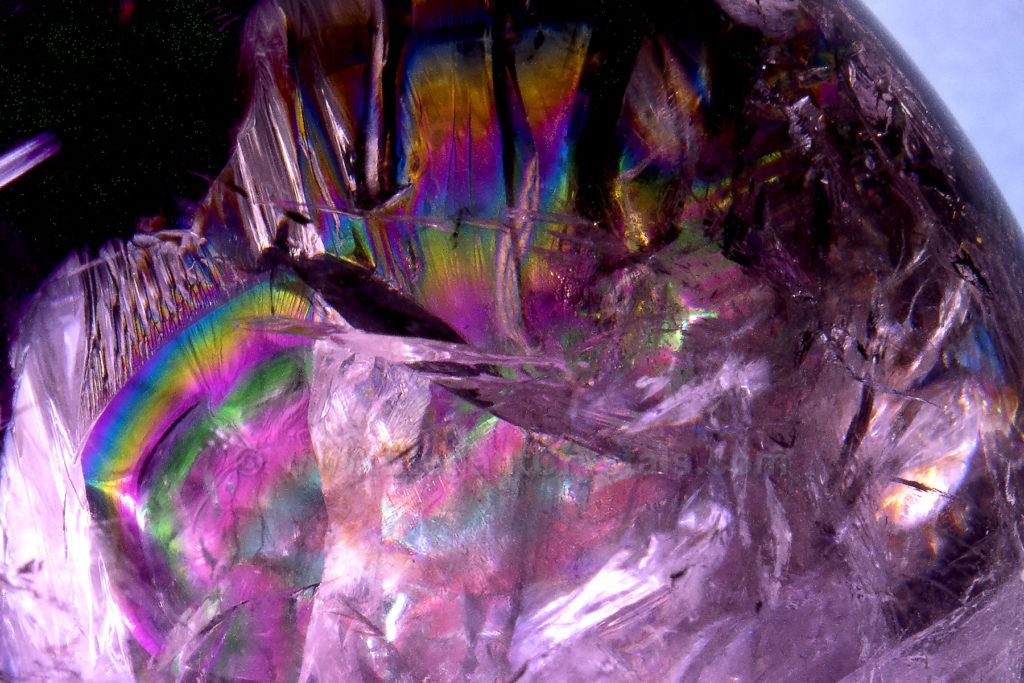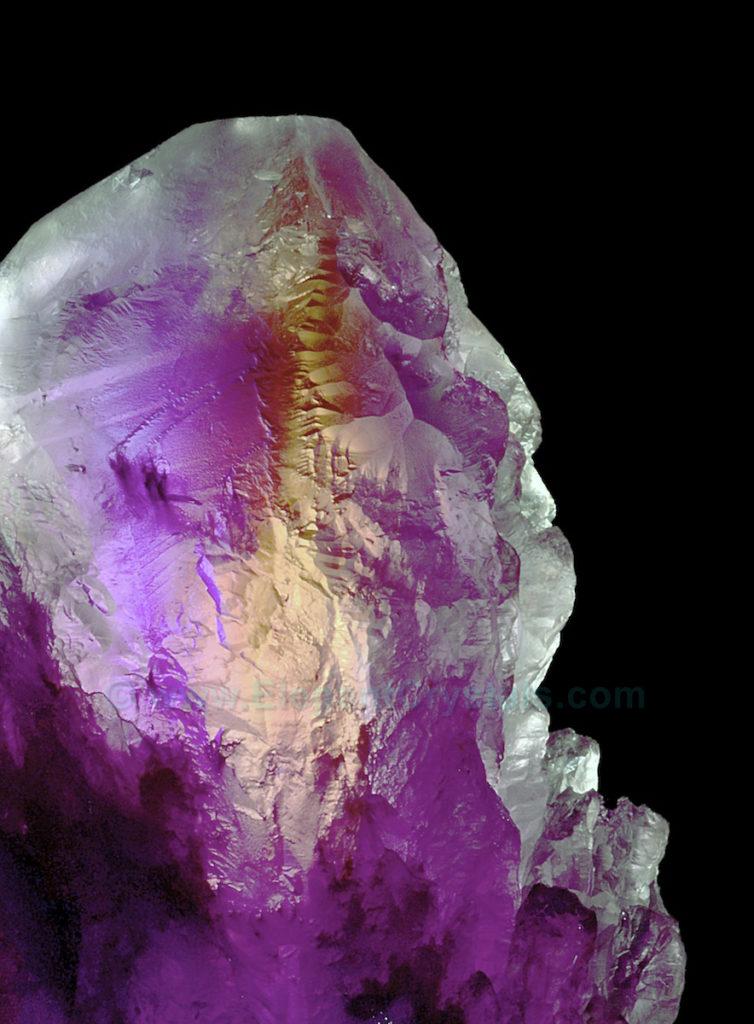CHAPTER 8
AMETHYST RAINBOWS

Picture #133
4-inch-wide Amethyst Quartz Ball
with Traces of Manganese and Iron Oxides
Most amethyst crystals tend to be rather small.
They are often heavily included with mist and fissures.
Although they may have small areas with spectral colors, I rarely see amethyst clear enough to view a large rainbow.
This globe is the exception.
The stone is from Brazil.
The ball was a gift from my Chinese friend and crystal supplier, the fabulous Mr. Qu.
We exchange gifts yearly, sending unusual crystals to each other to broaden our collections.
Not all of the gifts arrive in a timely fashion.
I sent Mr. Qu one of my framed rainbow pictures of this book’s cover, which never did arrive at his home.
One year and a week later, the Post office returned it to me, In perfect condition, with LOTS of postmarks from all over the world.
This may be a new record for delayed mail.
Meanwhile, I sent Mr. Qu a replacement gift, which arrived promptly.

Picture #134
Closeup image of a 4-inch-wide Amethyst Quartz Ball
Clear quartz and amethyst quartz are widely available from many countries, in many sizes.
Other quartz colors are less well distributed in the ground.
There is quite a bit of faceted smoky quartz available, and a few pieces of golden citrine quartz.
You may see many orange citrine geodes in stores, but please note that they used to be purple, and before being heat-treated.
Cooking amethyst geodes turns them permanently orange.
While this is an attractive color, it is by no means natural, and rarely occurs underground.
Tons of rose quartz are carved into crystal shapes in Brazil or Madagascar every year.
These originate as pink and pink/white boulders.
Naturally faceted rose quartz is hard to find.
It is scarce and seldom grows larger then 1/2-inch-long.
Likewise, faceted green quartz almost never occurs in nature, although it too can be created with heat treatments of amethyst.
Naturally faceted clear blue quartz is practically nonexistent, unless it contains copious blue inclusionary minerals.
I heard a story once about amethyst miners in Mexico.
They had uncovered a large group of amethyst crystals on a barren hillside in the mountains.
It was late in the day, so the miners decided to camp out and wait until morning to harvest the crystals.
They built a roaring campfire too close to the crystals.
In the morning, they found all the crystals had turned green!
These superstitious men fled the location without mining the crystals since they believed bad magic had ruined their gems.
I guess someone else completed the mining at a later date.
To this day, I have only seen one natural green quartz cluster from Uruguay.

Picture #135
Closeup Photo of a 4-inch-wide Amethyst Quartz Crystal
When an amethyst has an iris rainbow inside, all the colors take on a purple tinge.
Orange tones disappear almost entirely, absorbed by the violet pigment.
Silvery and white areas appear as lilac or lavender tones.
Th entire rainbow takes on a cool color cast.
As would be expected, the blue tones are strikingly amplified.
Since amethyst is generally a dark-colored stone, try shining a bright light into or through the crystal
to see what wonders are hidden inside.
Check out your new amethyst treasure in bright sunlight, but only for a few minutes.
Some amethyst will fade to white if left in the sun for long periods of time.
Over the years, an amethyst in a sunny window may turn dull or shift colors.
Back in 1985, I mistakenly put an amethyst cluster in direct sunlight in the Arizona desert for two weeks.
I didn’t notice it was fading, but finally realized it had turned pure white.
I was hugely disappointed to lose the beautiful color, and I even mourned a little bit over this shocking loss.

Picture #136
10-inch-long Ametrine Quartz Crystal
Some amethyst crystals from Santander, Bolivia
grow in layers or zones alternating with golden citrine.
This unique occurrence is called “ametrine.”
These strange Bolivian crystals are often sold in Brazil, where hardly any natural ametrine is found.
The combination of colors is very attractive, and yields unusual polished gems for jewelry.
The different colors are caused by varying amounts of iron and manganese oxides in the quartz.
More manganese produces amethyst while greater amounts of iron create citrine.
As the crystal is rotated, the colors blend in an ever-changing pageant of unique pastels.
I have yet to see a good iris rainbow inside an ametrine crystal.
If you have one, I will gladly photograph it for you, at no charge.
You can always contact me by E-mail.
